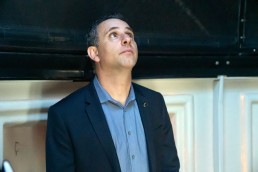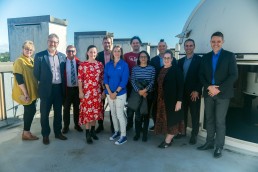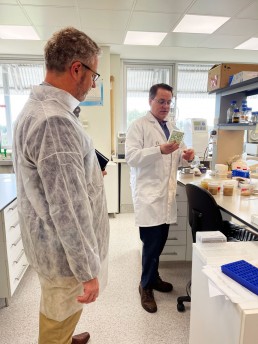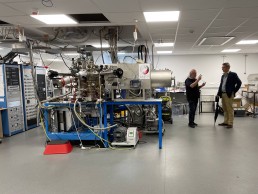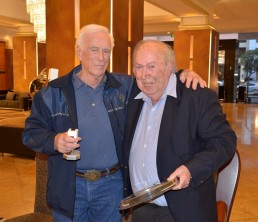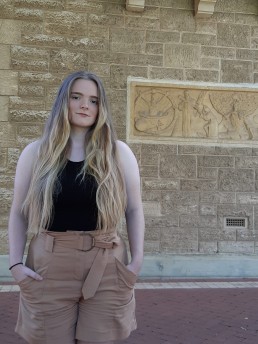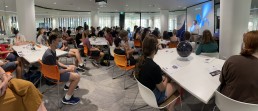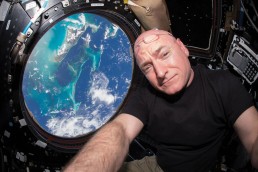Australian Space Agency Tour
It was a pleasure to tour ASA CEO Enrico Palermo and the Australian Space Agency around the International Space Centre facilities during their whirlwind tour to Perth. There was a lot to take in – the first expedition was to the WA Optical Ground Station which, amongst other specialities, is developing coherent free-space communication capabilities between Earth and low-Earth observation satellites.
The ASA’s Chris Hewett experienced the Plants in Space lab with Professor Harvey Millar, which examines questions of mission critical plant production on Mars missions for food, oxygen and wellbeing – and how we can apply that knowledge for on-Earth food security in zones of drought, low land availability. Chris also explored our work in the Microelectronics Research Group, led by Professor Lorenzo Faraone. This is one of Australia’s largest semiconductor electronics research groups, generating a combination of micro-electromechanical system (MEMS) with fourth-generation IR systems, optimised for use on satellites.
Growing Demand for Space Batteries
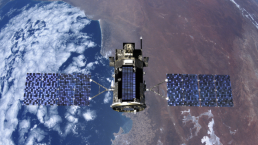
Professor Dongke Zhang from our Space Energy Node discusses the growing space and defence industries’ need for better batteries due to their demand for long-life power sources, and the radioactive space batteries he develops with our industry partners on RTRFM 92.1
NASA International Space Apps Challenge
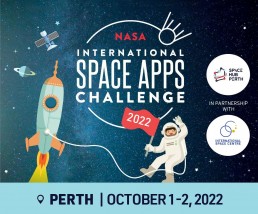
The International Space Centre is delighted to announce we are the primary partner of the NASA International Space Apps Challenge Space Apps Challenge for Perth, 2022 with Conrad Pires from Space Hub Perth.
Last year, over 28,000 people from around the world registered to address 28 challenges on Earth and in space using NASA’s open data. With over 4,000 teams from 162 countries and 2,814 submitted projects, Space Apps proves to inspire collaboration, creativity, and critical thinking that fosters interest in Earth and space science and exploration.
Watch our socials for more details on how to sign up, and be part of the action!
How does the International Space Centre support the future of the space industry in WA?
How does the ISC support the future of the space industry in WA?
Why is WA such a prime location to base space research and production? Get to know the ISC a little better, with this introduction from some of our space node leaders at our UWA location.
Inaugural Annual Report released
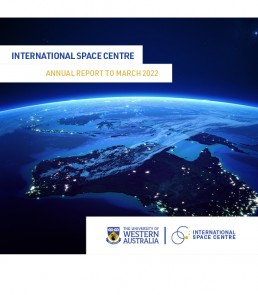
The International Space Centre is delighted to release the inaugural Annual Report for the Centre. Members of the public can download the Report at this link. We hope you enjoy reading our highlights from March 2021-2022.
Space batteries that last for decades funded in $2.4M grant.
Australia is set to play a world-leading role in the development of ultra longlasting batteries for space and defence applications. A $2.4 million grant has been awarded to a consortium led by PhosEnergy, including The University of South Australia, The University of Adelaide and the International Space Centre at The University of Western Australia, as well as industry partners DEWC Systems and Duromer Products. This grant of the Federal Government’s Cooperative Research Centres Projects (CRC-P) scheme will enable a $6 million program to develop the new GenX battery technology, which will provide electrical power for decades without human intervention.
The batteries, or GenX energy units, combine metals, semiconductors and beta-radiation to produce constant DC power over very long periods — a benefit required on long-term space missions and remote defence applications. The GenX technology was invented by PhosEnergy Managing Director Bryn Jones and Chief Scientist Dr Julian Kelly, with the collaborative project being led by General Manager Dr Scott Edwards. The growing space industry and increasingly sophisticated remote defence sites are creating enormous demand for long-life, fuel-free power sources.
“The market for power generation in space is already estimated to be worth $2.8 billion a year and is forecast to continue double-digit growth for the foreseeable future on the back of commercial and government space programs focus on extended missions, lunar occupation and resource recovery,” said Mr Jones.
“Demand from the defence industry is also soaring as more power-hungry technology is installed in remote locations. Secure integrated communications and sensor developments are driving the requirement for a portable and autonomous long-term power source,” he added.
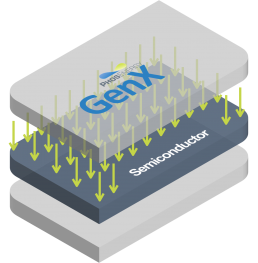
UWA Moon dust expert's legacy continues to shape space industry
UWA Moon dust expert's legacy continues to shape space industry
As we celebrate the 60th anniversary of astronaut John Glenn’s flyover, which put Perth on the space map, it is timely to remember the achievements of The University of Western Australia’s Adjunct Professor and physicist Brian O’Brien who helped NASA land on the Moon.
Professor O’Brien, who died in 2020, was fascinated by science and his lifelong passion for lunar research changed our understanding of the Moon, aided global space exploration and was pivotal to some of the successes of NASA.
Best known for his research into lunar dust, Professor O’Brien highlighted how hazardous it was for astronauts and their equipment.
He taught and collaborated with NASA astronauts Buzz Aldrin and Gene Cernan, believing the biggest challenge for lunar adventurers was indeed the movement of the fine, sticky Moon dust on which they were to land.
Professor O’Brien’s matchbox-sized dust detectors (Apollo Dust Detectors) were used throughout Apollo missions to record this movement, with the records sent back to Earth on magnetic tape.
His invention was deployed before either the Soviet Lunar 9 or the US Surveyor 1 had even taken the first photos of lunar soil.
Professor Peter Quinn, Chairman of the Board of UWA’s International Space Centre, said Professor O’Brien’s legacy remained strong with UWA institutions continuing to work with agencies such as NASA.
“He was a true supporter of UWA and its efforts in space, and never ceased in coming up with new ideas on how to explore the solar system,” Professor Quinn said.
“The International Space Centre continues to be involved with NASA – we’re funded by the Australian Space Agency to be part of the studies that are contributing to NASA’s Artemis mission to land men and first women on the moon this decade.”
Professor Quinn said Professor O’Brien helped shape the space industry when he rallied for it to recognise the dangers of space dust.
“As space moves into the private and civil sector, our strengths need to be about more than rockets and spacecraft,” Professor Quinn said.
“The International Space Centre is about all the challenges we are going to face to live and work in space. This includes the architecture of space habitats, medicine in space, agriculture in space, astronomy and yes, living on the moon and Mars.”
Media references
Larissa Wiese (International Space Centre Manager) 08 6488 1135
Annelies Gartner (UWA Media Advisor) 08 6488 6876
Scientists track space junk on path to collision with moon
Scientists track space junk on path to collision with the moon
The University of Western Australia’s Zadko Observatory team, in collaboration with the European Space Agency, have tracked an out-of-control booster rocket before it crashes into the dark side of the Moon.
The booster rocket was originally believed to be a part of a Space-X rocket weather satellite but it is now believed to be 2014-065B, the booster rocket for the Chinese Chang’e 5-T1 lunar mission.
It is possible the booster rocket has been in orbit between the Earth and the Moon since 2014 and scientists predict this large piece of space junk will collide with the Moon on March 4.
Associate Professor David Coward, an investigator for the Australian Research Council Centre of Excellence for Gravitational Wave Discovery and a member of the UWA International Space Centre, said there was a lot of junk in space.
“The space around Earth is becoming increasingly busy with orbiting debris and this debris is for the first time reaching the Moon,” Associate Professor Coward said.
The Zadko Observatory scientists at UWA’s Department of Physics are contracted by the European Space Agency to track potentially hazardous debris near Earth.
European Space Agency scientist Dr Marco Micheli said tracking the space junk with the Zadko Telescope was helping scientists refine the orbit and the location of the crash.
Zadko Observatory systems manager Dr Bruce Gendre said acquiring accurate positional data on an object 177,118km from Earth and travelling at over 700km per minute was not trivial.
“The exact impact site is uncertain because small effects, such as the rocket tumbling, changes the orbit slightly as it approaches the Moon,” Dr Gendre said.
Making things more difficult, UWA astrophysics student Eloise Moore had to battle with the Zadko telescope to regain control as its robotic system went rogue just as she was trying to take the images.
“We finally got control of the telescope only minutes before the critical imaging was due to start,” Ms Moore said.
At 4am on February 10, she succeeded in capturing some of the last images of the booster, which showed signs of the rockets tumbling as it hurtled through space before the expected collision.
“Even though the impact will occur on the dark side of the Moon, which is not visible from Earth, future lunar probes will be able to image the impact site to study effects of space junk on the lunar surface,” Ms Moore said.
Media references
Annelies Gartner (UWA Media Advisor) 08 6488 6876
Space Boot Camp gets 10/10 for fun!
Sixty Year 9 and 10 students from local high students quizzed our experts in all things space-related, at the year’s Space Boot Camp from the International Space Centre. Kids heard from those at the frontier of the Australian space industry including: ex-NASA scientists Professor Peter Quinn, Head of the International Centre for Radio Astronomy Research; and Associate Professor Danail Obreschkow, Head of the International Space Centre.
“It’s the perfect time for kids to think about a career in WA’s space sector, as our local space industry is quickly expanding its capabilities while witnessing a world-wide boom of exciting space missions,” Associate Professor Obreschkow said. “In fact, the Australian Space Agency looks to create another 20,000 space jobs over the next eight years.”
The group of new cadets learned about space plant biology, law, rocketry and propulsion – and even designing lunar habitats. The teenagers also be launched their own rockets with the UWA Aerospace Club.
“As kids, we used to think working in space meant becoming a rocket scientist or an astronaut – but the industry is so much broader than that, and that’s what the students this week have a chance to experience,” Associate Professor Obreschkow said.
“They’ll learn about things like human physiology in space, growing plants to support long-term missions, space debris and whose problem it is, robotics on the ISS and designing their own lunar habitats.
“All of these elements are crucial to our success in space as it becomes an increasingly civil industry. And of course, the students will get the chance to build and launch their own rockets as well, because space is fun!”
Students had a chance to quiz the brains of the International Space Centre’s stellar team of experts on the questions everyone wants to know such as: Who owns the moon? How expensive is it to store stuff in space? Are we alone? How does an astronaut go to the toilet?
70% of ISS astronauts receive damage to their eyes and brain - but how do you take pressure measurements in space?
Spaceflight Associated Neuro-Ocular Syndrome (SANS) affects 70% of ISS astronauts, causing the eye and brain structure to change in space. Weightlessness causes blood and cerebral spinal fluid to shift towards the head, and it’s one of the four top NASA space health priorities.
The International Space Centre’s Space Physiology and Medicine Node Leader and board member Professor Bill Morgan (MD Lions Eye Institute) spoke about SANS and measuring intracranial pressure in space at the Australian Space Biology x Health Summit on the Physiological Adaptations to Space Panel.
Australian Space Biology and Health Summit | ASBX 2021
#isc #internationalspacecentre #spacephysiology #spacemedicine #spaceopthalmology #spaceinwa #spaceindustry #data #medicine #health

